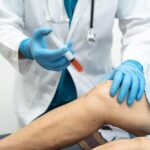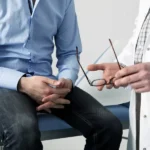The Role of Platelet-Rich Plasma (PRP) in Post-Operative Spinal Healing: Insights from Dr. Larry Davidson
As spinal surgery recovery protocols continue to develop, Platelet-Rich Plasma (PRP) therapy is gaining recognition as a supportive treatment for tissue repair and inflammation control. Dr. Larry Davidson, a leader in spinal surgery, recognizes that PRP offers a regenerative option to enhance healing after surgery while minimizing reliance on pharmaceuticals. With its growing role in orthopedic and sports medicine, PRP is now finding its place in spinal care as a natural, minimally invasive approach to post-operative recovery.
By utilizing the patient’s biology, PRP therapy may help accelerate healing, improve mobility and reduce discomfort in the weeks following surgery.
What Is PRP and How Is It Used?
Platelet-rich plasma is derived from a small sample of the patient’s blood. The sample is processed in a centrifuge, which separates the platelets and plasma from red and white blood cells. The resulting PRP solution contains a high concentration of platelets, components known for their role in clotting and wound repair, as well as numerous growth factors.
Once prepared, PRP is injected into targeted areas around the surgical site, including muscles, ligaments, tendons or soft tissue interfaces. These growth factors are believed to support healing by promoting cell regeneration, reducing inflammation and encouraging vascularization. The therapy is performed on an outpatient basis and typically takes less than an hour, making it accessible for most spinal surgery patients.
Benefits of PRP in Spinal Surgery Recovery
Post-operative spinal recovery often involves tissue trauma, inflammation and stiffness, particularly after procedures like spinal fusion, decompression or disc replacement. PRP therapy may help ease these challenges by providing localized biological support where healing is needed most.
Potential benefits of PRP in the context of spinal surgery include:
- Reduced inflammation: PRP contains cytokines that regulate the body’s inflammatory response, helping to control swelling and discomfort without suppressing healing.
- Accelerated tissue repair: Growth factors in PRP stimulate fibroblast activity, which plays a key role in regenerating soft tissues and strengthening the surgical area.
- Improved pain relief: By supporting tissue health and limiting inflammation, PRP may reduce the intensity and duration of post-operative pain.
- Minimized medication use: With enhanced healing, patients may require fewer doses of pain relievers, particularly opioids or NSAIDs.
- Support for adjacent structures: Injections can also be used in surrounding muscles or joints experiencing strain during the recovery process.
These outcomes make PRP an appealing option for patients seeking to optimize healing with fewer pharmaceutical interventions.
Ideal Candidates and Use Cases
PRP therapy is generally well-suited for patients undergoing spine procedures who want to support healing in a proactive, biologically based way. Ideal candidates include those:
- Undergoing microdiscectomy, laminectomy or fusion surgeries
- Experiencing post-operative inflammation in soft tissue structures
- With mild to moderate muscular strain in the post-surgical period
- Seeking alternatives to long-term NSAID use
- At risk for delayed wound healing or scar tissue formation
PRP can also be beneficial in treating inflammation at the donor site in cases where bone grafts are used. It is not typically used inside the spinal canal but rather in peri-spinal tissues, where it can provide the greatest benefit without added risk.
Dr. Larry Davidson points out, “Emerging minimally spinal surgical techniques have certainly changed the way that we are able to perform various types of spinal fusions. All of these innovations are aimed at allowing for an improved patient outcome and overall experience.” When paired with regenerative options like PRP, these surgical advancements contribute to a more biologically supportive and patient-tailored recovery process.
Safety and Efficacy of PRP Therapy
One of the main advantages of PRP therapy is its favorable safety profile. Since it uses autologous material, blood drawn from the same patient receiving the treatment, there is minimal risk of rejection or allergic reaction. The procedure itself is relatively simple, with most patients reporting only mild soreness or swelling at the injection site.
In terms of efficacy, PRP has shown promise in various orthopedic applications and early studies in spinal care suggest it may help reduce inflammation and improve post-operative pain outcomes. However, research is still ongoing, and results can vary depending on patient factors, the concentration of platelets and the specific condition being treated.
Integration Into Post-operative Protocols
PRP is not intended to replace standard surgical recovery protocols but rather to enhance them. It can be introduced at various points in the recovery timeline, often between two to six weeks post-surgery when soft tissue healing is underway and inflammation is still present.
Patients who receive PRP are usually advised to avoid strenuous activity for 24 to 48 hours, followed by a gradual return to their prescribed rehabilitation program. For optimal results, the injections may be paired with modalities like cryotherapy, bracing or electrical stimulation.
Monitoring and Adjusting PRP Treatment
The effects of PRP can take several weeks to become noticeable, and providers typically track patient outcomes using pain scores, range-of-motion assessments and imaging when necessary. Depending on their condition and response, some patients may benefit from multiple injections spaced out over several weeks or months.
Follow-up care is critical to ensuring PRP is contributing effectively to healing. Providers may adjust the dosage or injection location based on progress and communicate closely with physical therapists to align the treatment plan with the patient’s functional recovery.
Current Research and Future Potential
While PRP is already being used clinically in some spinal practices, ongoing research is examining its full potential in both post-operative and nonoperative spine care. Current studies are looking at its effects on disc degeneration, scar tissue prevention and post-fusion inflammation management.
Future developments may focus on refining platelet concentrations, combining PRP with stem cell injections or growth factor carriers and identifying biomarkers to predict which patients can benefit most. As the body of evidence grows, PRP may become a more standardized component of spinal surgery recovery.
With its ability to enhance healing naturally and reduce dependence on traditional medications, PRP therapy offers spinal patients an innovative pathway toward more comfortable, complete and personalized recovery.











